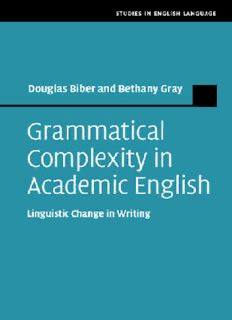
Grammatical Complexity in Academic English: Linguistic Change in Writing PDF
Preview Grammatical Complexity in Academic English: Linguistic Change in Writing
GRAMMATICAL COMPLEXITY IN ACADEMIC ENGLISH Grammatical Complexity in Academic English uses corpus-based ana- lysestochallengeanumberofdominantstereotypesandassumptions within linguistics. Biber and Gray tackle the nature of grammatical complexity, demonstrating that embedded phrasal structures are as importantasembeddeddependentclauses.Theauthorsalsooverturn ingrained assumptions about linguistic change, showing that gram- matical change occurs in writing as well as speech. This work estab- lishes that academic writing is structurally compressed (rather than elaborated);thatitisoftennotexplicitintheexpressionofmeaning; and that scientific academic writing has been the locus of some of the most important grammatical changes in English over the past 200 years (rather than beingconservative and resistant tochange). Supportedthroughoutwithtextualevidence,thisworkisessential readingfordiscourseanalysts,sociolinguists,andappliedlinguists,as well as descriptive linguists and historicallinguists. douglas biber is Regents’ Professor of Applied Linguistics in the English Department atNorthern Arizona University. bethanygrayisAssistantProfessorofEnglish(AppliedLinguistics and Technology) at Iowa State University. studies in english language Generaleditor: Merja Kytö (Uppsala University) Editorialboard:BasAarts(UniversityCollegeLondon),JohnAlgeo(Universityof Georgia),SusanFitzmaurice(UniversityofSheffield),ChristianMair(University of Freiburg),Charles F. Meyer (University ofMassachusetts) The aim of this series is to provide a framework for original studies of English, bothpresentdayandpast.Allbooksarebasedsecurelyonempiricalresearchand represent theoretical and descriptive contributions to our knowledge of national andinternationalvarietiesofEnglish,bothwrittenandspoken.Theseriescovers a broad range of topics and approaches, including syntax, phonology, grammar, vocabulary, discourse, pragmatics and sociolinguistics, and is aimed at an inter- national readership. Already published in this series jim feist: Premodifiers inEnglish: Their Structure and Significance steven jones, m. lynne murphy, carita paradis, and caroline willners: Antonyms inEnglish:Construals, Constructions and Canonicity christiane meierkord: Interactions across Englishes:Linguistic Choices inLocaland International Contact Situations haruko momma: From Philology to English Studies: Language and Culture inthe Nineteenth Century raymond hickey (ed.): Standards of English:Codified Varieties Around theWorld benedikt szmrecsanyi: Grammatical Variation inBritishEnglishDialects: A Studyin Corpus-Based Dialectometry daniel schreier and marianne hundt (eds.): Englishas aContact Language bas aarts, joanne close, geoffrey leech, and sean wallis (eds.): TheVerbPhraseinEnglish:InvestigatingRecentLanguageChangewithCorpora martin hilpert: ConstructionalChangein English: Developments in Allomorphy, Word Formation, and Syntax jakob r. e. leimgruber: SingaporeEnglish: Structure, Variationand Usage christoph ru¨hlemann: Narrativein EnglishConversation dagmar deuber: EnglishintheCaribbean:Variation,StyleandStandardsinJamaicaandTrinidad eva berlage: Noun PhraseComplexity in English nicole dehe´: Parentheticals in Spoken English: The Syntax-Prosody Relation jock onn wong: EnglishinSingapore: A Cultural Analysis anita auer, daniel schreier, and richard j. watts: Letter Writing and Language Change marianne hundt: Late Modern EnglishSyntax irmataavitsainen,merja kyto, claudia claridge, and jeremy smith: Developments inEnglish:Expanding Electronic Evidence arne lohmann: EnglishCo-ordinateConstructions:AProcessingPerspectiveonConstituentOrder john flowerdew and richard w. forest: Signalling Nouns inEnglish: A Corpus-Based Discourse Approach jeffrey p. williams, edgar w. schneider, peter trudgill, and daniel schreier: Further Studies in theLesser-Known Varieties ofEnglish nuria ya´n˜ez-bouza: Grammar, Rhetoricand Usage inEnglish: Preposition Placement 1500–1900 jack grieve: RegionalVariation inWrittenAmerican English douglas biber and bethany gray: Grammatical Complexity inAcademic English: Linguistic ChangeinWriting Earlier titles notlistedarealsoavailable GRAMMATICAL COMPLEXITY IN ACADEMIC ENGLISH Linguistic Change in Writing DOUGLAS BIBER NorthernArizonaUniversity BETHANY GRAY IowaStateUniversity UniversityPrintingHouse,Cambridgecb28bs,UnitedKingdom CambridgeUniversityPressispartoftheUniversityofCambridge. ItfurtherstheUniversity’smissionbydisseminatingknowledgeinthepursuitof education,learningandresearchatthehighestinternationallevelsofexcellence. www.cambridge.org Informationonthistitle:www.cambridge.org/9781107009264 ©DouglasBiberandBethanyGray2016 Thispublicationisincopyright.Subjecttostatutoryexception andtotheprovisionsofrelevantcollectivelicensingagreements, noreproductionofanypartmaytakeplacewithoutthewritten permissionofCambridgeUniversityPress. Firstpublished2016 AcataloguerecordforthispublicationisavailablefromtheBritishLibrary LibraryofCongressCataloguinginPublicationData Biber,Douglas,author. GrammaticalcomplexityinacademicEnglish:linguisticchangeinwriting/DouglasBiber,Northern ArizonaUniversity; BethanyGray,IowaStateUniversity. pagescm.– (StudiesinEnglishlanguage) Includesbibliographicalreferencesandindex. isbn978-1-107-00926-4(Hardback) 1. Englishlanguage–Grammar. 2. Complexity(Linguistics) 3. Academicwriting–Research. 4. Linguisticchange. I. Gray,Bethany,author. II. Title. p128.c664b472015 425–dc23 2015028909 isbn978-1-107-00926-4Hardback CambridgeUniversityPresshasnoresponsibilityforthepersistenceoraccuracy ofURLsforexternalorthird-partyinternetwebsitesreferredtointhispublication, anddoesnotguaranteethatanycontentonsuchwebsitesis,orwillremain, accurateorappropriate. Contents List of figures page x List of tables xiii 1 Academic writing: Challenging the stereotypes 1 1.1 Academese:Obtuseorinformational? 1 1.2 Describingthegrammarofacademicwriting 5 1.2.1 Academicwrittentexts:Allbasicallythesame? 7 1.2.2 Academicwriting:Complexgrammarandexplicitmeanings? 14 1.2.3 Academicwriting:Resistanttochangeordynamic? 19 1.3 GrammaticalchangeinEnglish:Belowtheradar? 27 1.4 Twotypesofgrammaticalchange 30 1.5 ThelocusofhistoricalchangeinEnglish:Speechorwriting? 32 1.6 Overviewofthepresentbook 39 2 Using corpora to analyze grammatical change 43 2.1 Introduction 43 2.2 Situationalchangewithinacademicresearchwriting 50 2.3 Corporaanalyzedinthebook 51 2.3.1 Representingacademicwritingovertime:Descriptionofthe diachronicacademiccorpora 52 2.3.2 Synchronicanddiachroniccomparisonsbetweenacademic writingandotherspokenandwrittenregisters 57 2.4 Corpusanalysisprocedures 58 2.5 Grammaticalfeaturesinvestigated 59 2.5.1 ‘Core’grammaticalfeaturesand‘colloquial’features 60 2.5.2 Phrasalandclausalcomplexityfeatures 60 2.5.3 Corpusanalysesofgrammaticalcomplexityfeatures 65 3 Phrasal versus clausal discourse styles: A synchronic grammatical description of academic writing contrasted with other registers 67 3.1 Introduction 67 3.2 Previouslinguisticresearchonacademicwriting 72 vii viii Contents 3.2.1 Studiesofparticulargrammaticalfeaturesinacademicwriting 74 3.2.2 Acomprehensivesurveyofthedistinctivegrammaticalfeatures ofacademicwriting:ContributionsfromTheLongman GrammarofSpokenandWrittenEnglish 76 3.2.3 Studiesofregistervariationthatincludeacademicwriting 83 3.3 Casestudiesillustratingthedistinctivegrammaticalcharacteristics ofacademicresearchwriting 87 3.3.1 Academicwritingcontrastedwithconversation:Whichismore grammaticallycomplex? 87 3.3.2 Universitytextbookscontrastedwithuniversityclassroom teaching:Isthereageneralacademicstyle? 100 3.3.3 Grammaticalfeaturesofacademicwritingcontrastedwith popularwrittenregisters 104 3.3.4 Grammaticalvariationamongwrittensub-registersfrom differentacademicdisciplines 111 3.4 Chaptersummary 123 4 The historical evolution of phrasal discourse styles in academic writing 125 4.1 Grammaticalcomplexityineighteenthcenturywrittentexts 125 4.1.1 Theinfluenceofpopularizationversuseconomyinhistoricalchange 128 4.1.2 PrevioushistoricalresearchonthenounphraseinEnglish 130 4.2 GeneralpatternsofchangeinwrittenEnglishregisters 132 4.2.1 Increasinguseofcolloquialfeatures 136 4.2.2 Historicalchangeintheuseofcomplexityfeatures 140 4.2.3 Exploringthemagnitudeofchange:Theevolutionofaphrasal discoursestyle 145 4.3 Whatfeatureshavedecreasedinuseinacademicprose? 154 4.4 Historicalchangeacrosssub-registerswithinacademicresearchwriting 157 4.5 Chaptersummary 166 5 The functional extension of phrasal grammatical features in academic writing 167 5.1 Introduction 167 5.2 Phrasalfeaturesfunctioningaspre-modifiersofaheadnoun 170 5.2.1 Nounsasnominalpre-modifiers 170 5.2.2 Attributiveadjectivesasnominalpre-modifiers 184 5.2.3 Noun–participlecompoundsasnominalpre-modifiers 187 5.3 Phrasalfeaturesfunctioningaspost-modifiersofaheadnoun 190 5.3.1 Prepositionalphrasesasnominalpost-modifiers 190 5.3.2 Appositivenounphrasesasnominalpost-modifiers 202 5.4 Thesystemic‘drift’towardsstructuralcompression,motivatedby economyofexpression 207
Description: